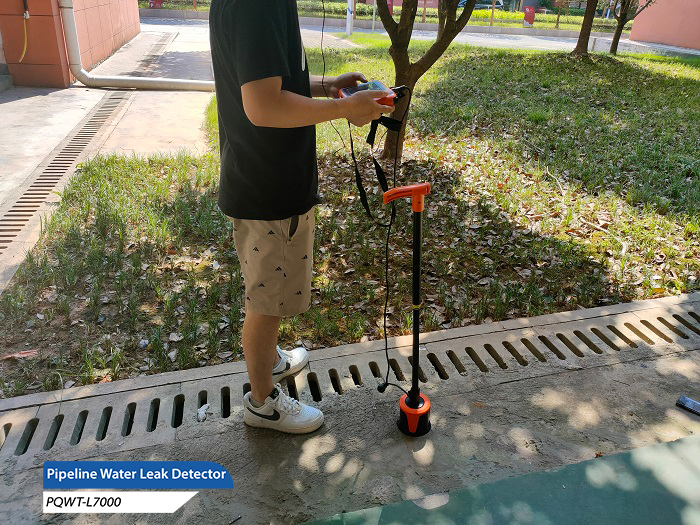There are various methods to detect leaks in underground pipelines and water supply pipelines, each with its own advantages and disadvantages, suitable for different scenarios and needs. Here are some commonly used detection methods:

1、 Auditory testing method
The auditory detection method is one of the most traditional and fundamental leak detection methods. It relies on operators using tools such as listening sticks or electronic pipeline leak detectors to listen to the sound of water leakage on the ground above or near the pipeline. When water flows through cracks or holes, specific "hissing" or "thumping" sounds are produced. These sounds propagate underground and are filtered by media such as soil and rocks. Although they are weakened when they reach the surface, they can still be captured by experienced inspectors. This method is low-cost, easy to operate, and suitable for preliminary screening and localization of small-scale water leakage points in shallow buried pipelines.
2、 Pipeline endoscopic inspection method
For pipelines with large burial depths or requiring precise detection, pipeline endoscopic inspection method becomes the preferred method. This technology utilizes CCTV (closed-circuit television) cameras or intelligent crawling robots, equipped with high-definition cameras, lighting systems, and positioning devices, to enter the interior of pipelines for visual inspection. Through real-time transmission of video images, inspectors can clearly observe the condition of the inner wall of the pipeline, including cracks, corrosion, sediment, and illegal access issues, thereby accurately determining the location and cause of water leakage. In addition, some advanced systems also have automatic analysis functions that can identify and mark abnormal areas, improving detection efficiency and accuracy.
3、 Flow balance testing method
The flow balance testing method is an indirect method for detecting water leakage, which is based on the law of conservation of mass. It determines whether there is water leakage by comparing the flow difference between the inlet and outlet ends of the pipeline system. When performing specific operations, it is necessary to first turn off all external water equipment to ensure that the system is in a static state, and then measure the instantaneous flow rate at the inlet and outlet ends. The difference between the two is calculated as the leakage loss. This method is suitable for leakage assessment of large-scale water supply systems, which can quickly estimate the leakage rate of the entire system and provide a basis for developing maintenance plans. However, it should be noted that this method cannot directly locate the leakage point and needs to be combined with other detection methods for precise positioning.
4、 Infrared thermography method
Infrared thermography analyzes temperature anomalies to determine if there is a water leakage problem. When water flows out through a leak in a pipeline, it takes away the heat from surrounding objects, causing a decrease in temperature in that area and creating a noticeable temperature anomaly zone. By using an infrared thermal imager, water leakage points can be quickly and accurately located. The advantage of this method is non-invasive, without the need to damage pipelines or walls, but it also requires professional instruments and technicians to operate.
5、 Stress testing method
The pressure testing method is a commonly used method for detecting water leakage in tap water pipelines. By applying a certain pressure in the pipeline and observing the pressure changes, it can be determined whether there is a water leakage problem. During the testing process, pressure gauges or pressure sensors can be used to record changes in pipeline pressure. If the pipeline pressure continues to decrease or drops sharply, there may be a problem of water leakage. The advantage of this method is that it can detect water leakage problems in large areas of pipelines and quantitatively understand the degree of water leakage. However, it requires professional instruments and technicians to operate, and may cause certain pressure effects on the pipeline.
6、 Leakage indicator method
The leakage indicator method is a simple and effective detection method. People can add a special dyeing liquid or powder to tap water and observe whether it leaks out at the pipe leak to determine if there is a water leakage problem. This method is simple and easy to implement, does not require professional instruments, and is suitable for home self testing. However, it can only help people determine whether there is a leakage problem and cannot accurately locate the leakage point.
7、 Visual inspection
Visual inspection is an intuitive and simple preliminary detection method. You can carefully observe whether there are suspicious signs of moisture, water or leakage around the water pipeline. Pay special attention to areas such as walls, floors, ceilings, etc. that are susceptible to water damage. Although this method is simple, it may not be suitable for unexposed pipeline sections and there may be inaccurate judgments.
8、 Auditory examination
Auditory examination is also a commonly used preliminary detection method. After turning off all tap water and faucets, focus on listening for possible leaking sounds in a silent environment. If you can hear subtle dripping or leaking sounds, it may indicate a water leakage problem.
In summary, detecting leaks in underground pipelines and water supply pipelines requires selecting appropriate detection methods based on specific circumstances. In practical applications, it may be necessary to integrate multiple methods to make comprehensive judgments and locate leakage points. Meanwhile, in order to ensure the accuracy and safety of the testing, it is recommended to have professional testing personnel or institutions carry out the operation.








